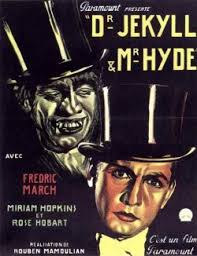
Dr. Henry Jekyll (Fredric March) is a well respected man in medical circles although some believe he is a little radical in some of his beliefs. Jekyll is engaged to Muriel Carew (Rose Hobart). The wedding is not scheduled for another eight months but Jekyll is anxious to be married and wants to move the date up. Muriel’s father, Brigadier General Danvers Carew (Halliwell Hobbes), is against the idea. Waiting to get married was good enough for him so it should be good enough for Jekyll. Muriel won’t go against her father so Jekyll ends p frustrated with the situation.
While walking home with his friend, John Lanyon (Holmes Herbert), Jekyll sees a woman being attacked by a man. Coming to her aid the man is chased away and Jekyll carries the young woman upstairs to her flat. The young woman’s name is Ivy Pearson (Miriam Hopkins). Ivy is of a lower class and a bit of a free spirit. While Jekyll is trying to tend to her as a doctor she is trying to seduce him. Jekyll is amused by the attention and eventually extracts himself from the situation when Lanyon walks in.
Jekyll gets upset when he finds out that Carew took Muriel out of town for a couple months. With time on his hands he delves deeper into his idea that you can separate the evil side of a person from the good side. Jekyll begins experimenting with various drugs and drug combinations. Eventually he makes a drug combination that he believes will release his evil side. He drinks it and changes into a simian looking monster called Edward Hyde (Fredric March). Remembering his acquaintance with Miss Ivy he goes to her flat. Her landlady directs him to the local pub. Now calling himself Mr. Hyde he propositions the girl telling her he will support her. So begins a nightmare for Ivy. Hyde abuses her physically, sexually and psychologically.
When Jekyll finds out that Muriel is coming back he decides that Hyde will have to go. He sends some money to Ivy as restitution. Not knowing why she received this gift, Ivy visits Jekyll to thank him and realizes he is the man she met before. Ivy breaks down and confesses what she’s been through with Hyde. Jekyll promises Hyde will never bother her again. Later Jekyll spontaneously turns into Hyde. He goes to Ivy’s rooms and kills her. Now Jekyll is an animal on the run.
“Dr. Jekyll and Mr. Hyde” was released in 1931 and was directed by Rouben Mamoulian. It is an American pre-code horror film and was adapted from the 1886 novel “The Strange Case of Dr. Jekyll and Mr. Hyde” by Robert Louis Stevenson. The movie was rereleased in 1935. By then the Production Code was in full force so the filmmakers had to cut about 8 minutes of the film in order to release it. Eventually pretty much all of the missing footage was restored for the VHS and DVD releases.
The movie is one of the better adaptations of the Jekyll and Hyde story. My favorite is the silent version with John Barrymore but this one is a close second.
The sound of the pounding heart in the transformation scene was director Mamoulian's. He recorded it after running up and down the stairs for two minutes.
The secret of Fredric March’s transformation scenes was not revealed for decades. Make-up was applied in contrasting colors. A series of colored filters that matched the make-up was then used which enabled the make-up to be gradually exposed or made invisible. This effect can only be done on a black and white movie. A similar effect was done in the silent movie “Ben-Hur: A Tale of Christ” 1925.
MGM remade “Dr. Jekyll and Mr. Hyde” in 1941 starring Spencer Tracy. They bought the rights to both the 1931 version and the 1920 silent version with John Barrymore. They then destroyed every print they could find of the 1931 version. For decades the 1931 film was believed to be lost.
There are stills of Hyde trampling a child but there is nothing in the film about it. The question came up as to whether or not the scene ever existed. Mamoulian claims that the publicity photo was done but it was never filmed. No one really knows if it was or not.

